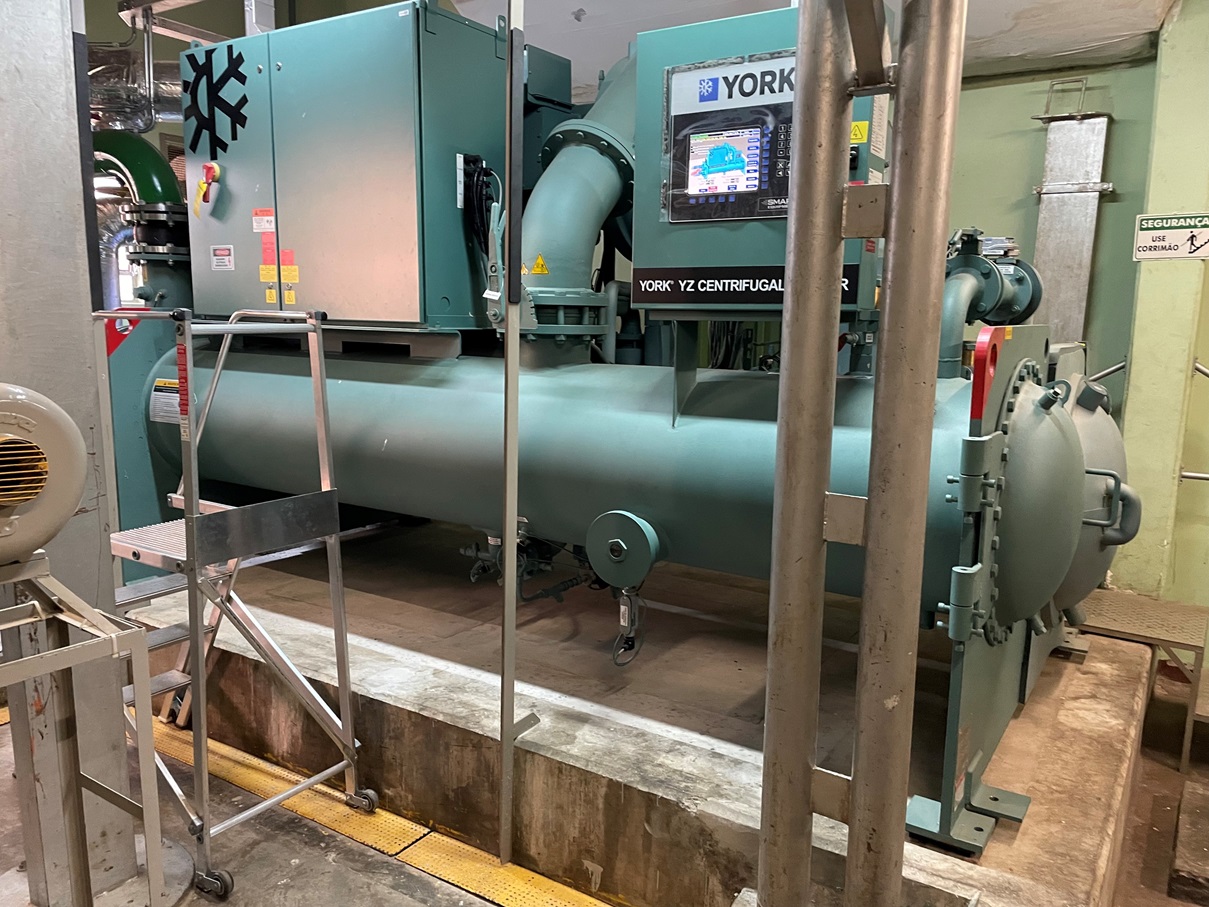Basic Concept
The Nisshinbo Group's Business Conduct Guidelines include Awareness and Concern towards its environmental impact. The Group is committed to reducing greenhouse gas emissions and providing decarbonized technologies, products, and services to faithfully realize a safe and secure society for all people. The Group manages key performance indicators (KPIs) as part of the systematic measures to achieve its environmental targets for reducing greenhouse gas emissions*1 and expanding sales of products that contribute to a sustainable society.
【Main measures】
- ① The Group is advancing reduction of greenhouse gas emissions through ISO 14001 activities.
- ② The Group is advancing activities to reduce Scope1 (in-house emissions) and Scope2 (off-site emissions of electricity, etc.) at manufacturing sites, and to establish environmentally friendly facilities.
- ③ The Group is promoting new solar power generation facilities and switch to electricity derived from renewable energy sources.
- ④ In the Wireless and Communications business, the Group is offering products for adaptation to climate change. These include dam and river management systems to prevent flooding damage and disaster prevention notification and communication systems to protect local residents in the event of a disaster.
- ⑤ In the Micro Devices business, the Group is expanding equipment to reduce the emissions of PFCs gas*2 from semiconductor production facilities.
- ⑥ The Group is developing, manufacturing and sell ingseparator materials, core components of the fuel cells that contribute to the development of a hydrogen-based society, in the Chemicals business.
*1 Greenhouse gas emissions are targeted by Scope1+Scope2
*2 PFCs: Fluorinated greenhouse gases used in dry etching and other processes in semiconductor manufacturing
Please refer to "Promotion System" in "Environmental Management" for the promotion system.
Specific Initiatives of The Nisshinbo Group
Greenhouse Gas Emissions Reduction Targets
The Nisshinbo Group aims to capture climate change-related business opportunities and reduce risks. In order to reduce climate-related risks, the Group declared in June 2022 to be carbon neutral by 2050 and have set a new long-term environmental target with 2050 as the year of achievement. With the achievement of carbon neutrality as its top priority, the Group actively promoting climate change countermeasures such as energy conservation activities, switching to electricity derived from renewable energy, and reducing emissions of PFCs (perfluorocarbons).
The Nisshinbo Group’s Greenhouse Gas Emissions Reduction Targets
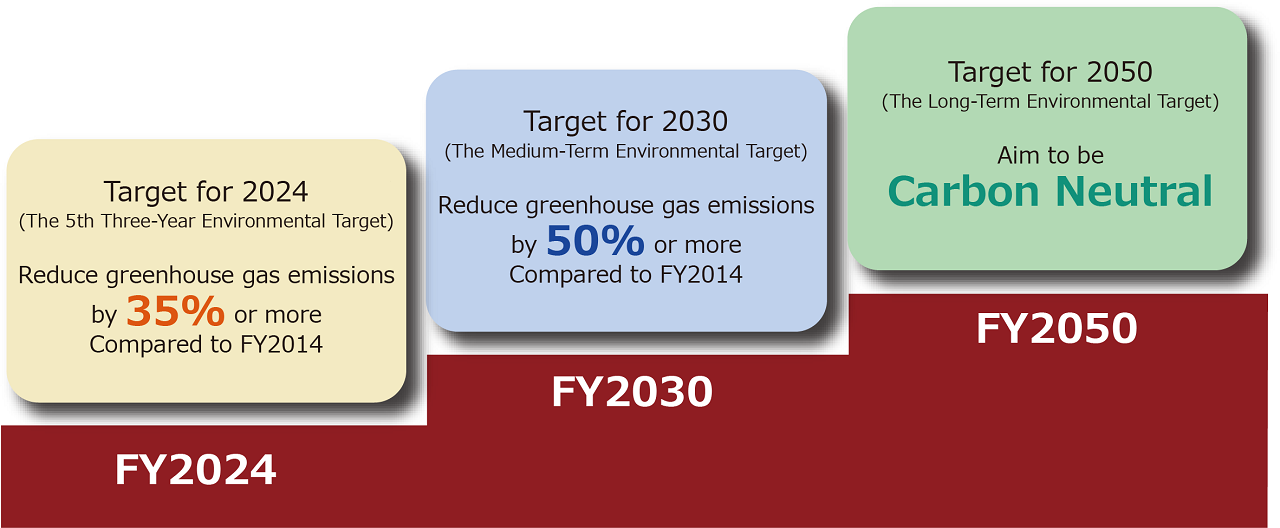
Please refer to "Environmental Management" for The Group's Environmental Targets and "Material Balance" for business activities and environmental impacts.
Outline of TCFD Response
Climate change is a global challenge for all countries and regions, and the reduction of greenhouse gases is a global long-term target. The Nisshinbo Group believes that it is crucial to incorporate business opportunities caused by climate change and appropriately respond to risks. Accordingly, in FY2021 the Group began analyzing climate change scenarios in accordance with the recommendations of the Task Force on Climate-related Financial Disclosure (TCFD)*1. In June 2022, the company expressed its agreement to the TCFD recommendations.
Since the Nisshinbo Group has a wide range of businesses, a climate change scenario analysis was conducted in stages starting in FY2021, and an analysis of the Group's major businesses was completed*2 in FY2023.
In FY2021, the Group targeted the Solutions business in the Wireless and Communications business, the Automobile Brakes business, and the Chemicals business that are expected to have a large risk/opportunity impact. In FY2022, the analysis was conducted in major businesses with production activities by covering the Marine System, ICT/Mechatronics, and Mobility business in the Wireless and Communications business, the Micro Devices business, the Precision Instruments business, and the Textiles business. For FY2023, the scope of the program includes Medical Equipment business in the Wireless and Communications business, Real Estate business, and Other businesses, as well as initiatives in the Business Development Division. Through climate change scenario analyses, the Group will identify the risks and opportunities that climate change may pose to the business in future, develop more flexible and robust strategies by leveraging the opportunities in the development of business strategies, and increase the resilience against future risks.
Please refer to "Disclosure Based on TCFD Recommendations" for the results of climate change scenario analyses.
*1 TCFD: The Task Force on Climate-related Financial Disclosure established by the Financial Stability Board (FSB)
*2 Excluding Hitachi Kokusai Electric Inc., which became a subsidiary of the Nisshinbo Holdings Inc. in December 2023
Independent Practitioner's Assurance of Environmental Data
The Nisshinbo Group obtained independent practitioner's assurance from Deloitte Tohmatsu Sustainability Co., Ltd. in its Nisshinbo Group Greenhouse Gas Emissions Data 2023 in the Japanese version to improve the reliability of its Greenhouse Gas Emissions (Scope1, Scope2) environmental performance data.
Greenhouse Gas Emissions
The Nisshinbo Group's greenhouse gas emissions (Scope1 + Scope2) in FY2023 were 368.5 thousand t-CO2e, down 16% from the previous fiscal year's greenhouse gas emissions.
PT. Nikawa Textile Industry (Indonesia), Textiles business, has stopped using coal boilers and eliminated the use of coal as of November 2021, and three bases in Indonesia, including the company, gradually switched all electricity purchases to electricity derived from renewable energy sources, such as geothermal power, from mid-2022. As a result of these and other factors, the Group's energy-related greenhouse gas emissions have been significantly reduced as of 2022. The expansion of solar power generation facilities in Japan and overseas and the switch to electricity derived from renewable energy sources for purchased electricity increased the share of electricity used by the Group from renewable energy sources to 21% (8% in the previous year), which further reduced greenhouse gas emissions in FY2023.
Perfluorocarbons (PFCs) composed 81% of non-energy related greenhouse gas emissions. The PFCs emissions were mainly from the semiconductor product manufacturing process in the Micro Devices business. Emissions decreased from previous fiscal year levels from the installation of additional PFCs abatement equipment and a decrease in production volume due to sluggish demand for semiconductors.
The Nisshinbo Group's actual greenhouse gas emissions (Scope 3) in FY2023 were approximately 1,915 thousand t-CO2e, up 19% from the previous fiscal year's greenhouse gas emissions. The increase was mainly due to improved statistical accuracy at overseas sites. Please refer to "Environmental Data" in "Sustainability Data" for details on Scope 3, which consists of 15 categories.
Trends in Greenhouse Gas Emissions(Scope1+Scope2)
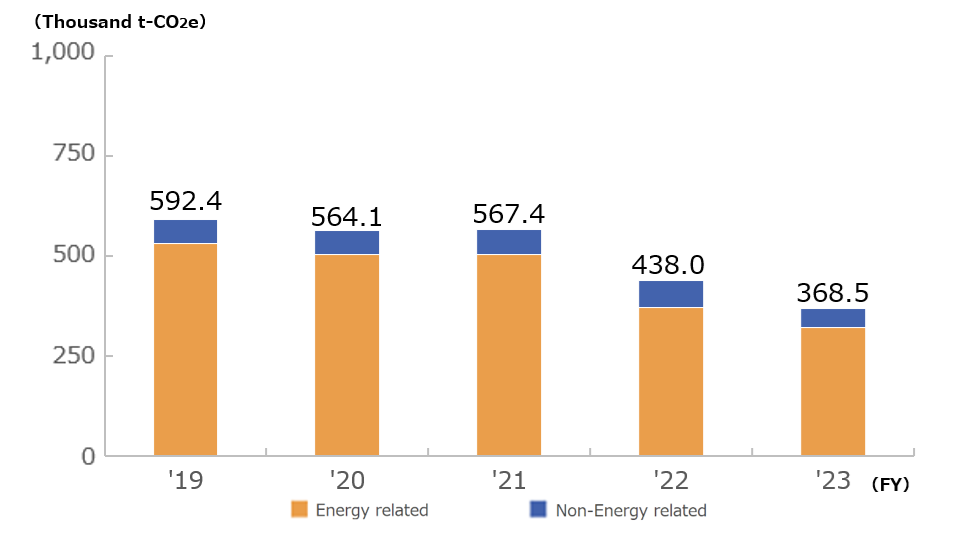
*1 Because of the transfer of all shares of TMD FRICTION GROUP S.A. (TMD), a subsidiary in the Automobile Brakes business, on November 30, 2023, and for other factors, TMD and 21 other companies were excluded from the scope of consolidation. Therefore, TMD and 21 other companies are included in the data until November 2023.
*2 On December 27, 2023, HVJ Holdings, Inc. and its subsidiary Hitachi Kokusai Electric Inc. and 7 other companies were included in the scope of consolidation, but are not included in the data for FY2023.
Greenhouse Gas Emissions by Scope(Scope1+Scope2)
(Thousand t-CO2e)
| 2019 | 2020 | 2021 | 2022 | 2023 | |||
|---|---|---|---|---|---|---|---|
| Greenhouse Gas Emissions | Scope1 | (Energy related + Non-Energy related) |
243.8 | 246.7 | 237.9 | 134.6 | 109.3 |
| (Energy related) | 183.1 | 187.7 | 173.7 | 66.7 | 63.4 | ||
| (Non-Energy related) | 60.7 | 59.0 | 64.2 | 67.9 | 45.9 | ||
| Scope2 | (Energy related) | 348.6 | 317.4 | 329.4 | 303.4 | 259.2 | |
| Scope1 + Scope2 |
(Energy related + Non-Energy related) |
592.4 | 564.1 | 567.4 | 438.0 | 368.5* | |
| (Energy related) | 531.7 | 505.1 | 503.1 | 370.2 | 322.7 |
* Data on greenhouse gas emissions(Scope1+Scope2)are assured by a third party (Deloitte Tohmatsu Sustainability Co., Ltd.).
[Calculation method]
・Scope1:
Energy related Greenhouse Gas Emissions = Σ[Fuel Consumption × CO2 Emission Factor*1]
Non-Energy related Greenhouse Gas Emissions = Non-Energy related CO2 Emissions + Σ [Greenhouse Gas Emissions other than CO2 × Global Warming Potential*2]
*1 Emission factors based on the Act on Promotion of Global Warming Countermeasures are used. Coal, however, uses a factor calculated based on actual calorific values, which is 1.870 t-CO2/t in FY2023.
*2 Global warming potential based on the Act on Promotion of Global Warming Countermeasures.
・Scope2:
Energy related Greenhouse Gas emissions = Σ [purchased electricity and purchased steam volume x CO2 emission factor*3]
*3 Purchased electricity uses, in Japan, adjusted emission factors for each electric company based on the Act on Promotion of Global Warming Countermeasures, and in foreign countries, the emission factors for each electric company, and if unavailable, t he relevant year country-specific emission data of IEA Emissions Factors. Data for FY2021 and earlier use country-specific emission factors for each year from "IEA Emissions Factors 2021". For purchased steam, the emission factor calculated by the purchasing company (0.0583 t-CO2/GJ in FY2023) is used.
【Subject organizations】
In FY2023, a total of 98 companies, including Nisshinbo Holdings Inc. and 97 consolidated subsidiaries, were
counted.
As stated in *1*2 of the Greenhouse Gas Emissions Trends, the number of subsidiaries includes TMD and 21 other
companies and does not include HVJ Holding, Inc., and Hitachi Kokusai Electric Inc. and 7 other companies, which are
subsidiaries of HVJ Holdings, Inc.
In greenhouse gas emissions by business, the Micro Devices business accounted for 37% of total emissions. This was followed by the Automobile Brakes business, which accounted for 26%.
Greenhouse Gas Emissions by Business(Scope1+Scope2)
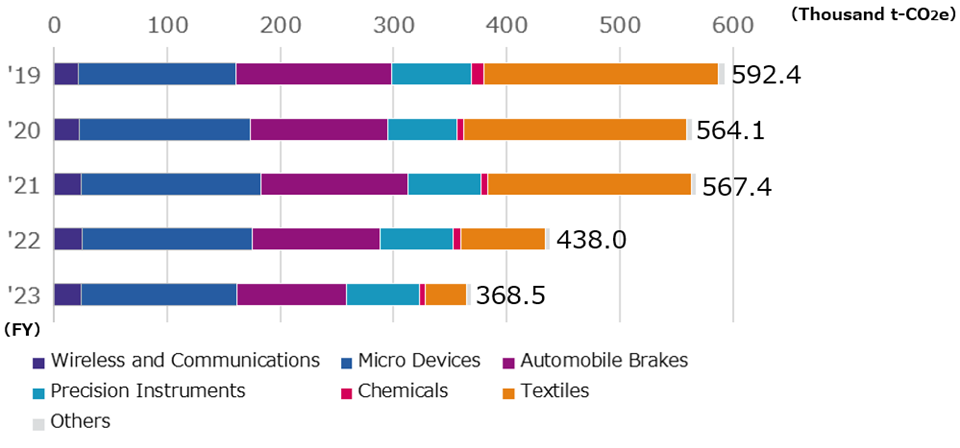
*1 TMD FRICTION GROUP S.A. ("TMD") and 21 other companies were excluded from the scope of consolidation due to the transfer of all shares of TMD, a subsidiary in the Automobile Brakes business, on November 30, 2023. Therefore, TMD and 21 other companies are included in the data until November 2023.
*2 On December 27, 2023, HVJ Holdings, Inc. and Hitachi Kokusai Electric Inc. which is a subsidiary of HVJ Holdings, Inc. and seven other companies were included in the scope of consolidation, but are not included in the data for FY2023.
Of the Nisshinbo Group's greenhouse gas emissions, the proportion in Japan accounts for 53%.
Greenhouse Gas Emissions in Japan and Overseas(Scope1+Scope2)
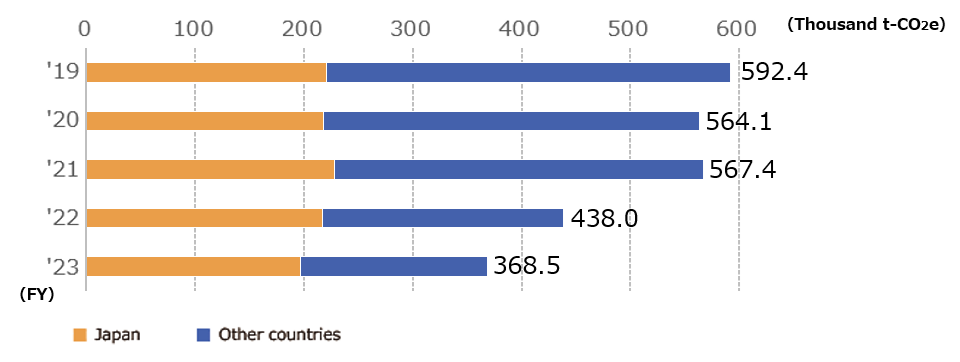
*1 TMD FRICTION GROUP S.A. ("TMD") and 21 other companies were excluded from the scope of consolidation due to the transfer of all shares of TMD, a subsidiary in the Automobile Brakes business, on November 30, 2023. Therefore, TMD and 21 other companies are included in the data until November 2023.
*2 On December 27, 2023, HVJ Holdings, Inc. and Hitachi Kokusai Electric Inc. which is a subsidiary of HVJ Holdings, Inc. and seven other companies were included in the scope of consolidation, but are not included in the data for FY2023.
Renewable Energy
The Nisshinbo Group promotes the use of renewable energy, and in FY2023, 21% of the electricity used by the Group was derived from renewable energy.
Solar Power Generation (excluding PPA)
Solar power generation equipment installed by the Nisshinbo Group remained steady, generating 7.1 thousand MWh of power in FY2023.
| Installation site | Generation capacity (kW) | Year operation commenced | Use |
|---|---|---|---|
|
Nisshinbo Mechatronics Inc. Miai Machinery Plant |
430 | 2010 | Self-consumption |
|
Nisshinbo Chemical Inc. Chiba Plant |
150 | 2011 |
Electric power sales, Self-consumption |
|
Nisshinbo Brake Inc. Tatebayashi Plant |
300 | 2011 | Self-consumption |
|
Nagano Japan Radio Co., Ltd. Head Office & Factory |
110 | 2013 | Electric power sales |
|
Nisshinbo Holdings Inc. Tokushima Plant |
1,768 | 2013 | Electric power sales |
| Nisshinbo Precision Instrument & Machinery Hiroshima Corp. | 1,020 | 2015 | Electric power sales |
|
Nisshinbo Micro Device Inc. Kawagoe Works |
19 | 2018 | Self-consumption |
| Nisshinbo Micro Devices (Thailand) Co.,Ltd. | 1,524 | 2022 | Self-consumption |
| Total | 5,321 | ||
Purchase of Electricity Derived from Renewable Energy
The Nisshinbo Group is promoting the switch to electricity derived from renewable energy, and purchased approximately 154.4 thousand MWh of electricity derived from renewable energy in FY2023.
Nisshinbo Holdings Inc., Head Office, purchases electricity derived from hydroelectric and solar power generation; and Japan Radio Co., Ltd. Nagano Plant, Ueda Logistics Center, Nagano Japan Radio Co., Ltd. Head Office & Factory, Ueda Japan Radio Co., Ltd. Head Office & Main Factory in the Wireless and Communications business purchase green power derived from hydroelectric power generation; and Nisshinbo Brake Inc. Tatebayashi Plant, Nisshinbo Somboon Automotive Co., Ltd., Nisshinbo Automotive Manufacturing Inc. in the Automobile Brakes business purchase electricity derived from solar power generation; and PT. Nikawa Textile Industry, PT. Nisshinbo Indonesia and PT. Naigai Shirts Indonesia in Textiles businesses purchase electricity derived from geothermal power generation.
Purchased Electricity from Renewable Energy Sources by Major Business Sites (FY2023)
| Segment | Company / Plant | Retailer | Category | Purchase Amount(MWh) |
|---|---|---|---|---|
| Wireless and Communications |
Japan Radio Co., Ltd. Nagano Plant |
Chubu Electric Power Miraiz Company, Incorporated | Hydroelectric power | 1,350 |
| Wireless and Communications |
Japan Radio Co., Ltd. Ueda Logistics Center |
Chubu Electric Power Miraiz Company, Incorporated | Hydroelectric power | 1,350 |
| Wireless and Communications |
Nagano Japan Radio Co., Ltd. Head Office & Factory |
Chubu Electric Power Miraiz Company, Incorporated | Hydroelectric power | 360 |
| Wireless and Communications |
Ueda Japan Radio Co., Ltd. Head Office & Main Factory |
Chubu Electric Power Miraiz Company, Incorporated | Hydroelectric power | 198 |
| Automobile Brakes |
Nisshinbo Brake Inc. Tatebayashi Plant |
West Holdings Corporation | Solar power by PPA* | 934 |
| Automobile Brakes |
Nisshinbo Automotive Manufacturing Inc. |
Sterling Planet | Solar power | 923 |
| Automobile Brakes |
Nisshinbo Somboon Automotive Co.,Ltd. |
WEST International (Thailand) Co.,Ltd. |
Solar power by PPA* | 1,592 |
| Textiles |
PT. Nisshinbo Indonesia |
PT Perusahaan Listrik Negara (Persero) ("PLN") | Geothermal power | 11,166 |
| Textiles | PT. Nikawa Textile Industry |
PT Perusahaan Listrik Negara (Persero) ("PLN") | Geothermal power | 69,239 |
| Textiles | PT. Naigai Shirts Indonesia |
PT Perusahaan Listrik Negara (Persero) ("PLN") | Geothermal power | 1,955 |
| Nisshinbo Holdings Inc. and others |
Nisshinbo Holdings Inc. Head Office |
TEPCO Energy Partner, Incorporated | Hydroelectric power | 832 |
* PPA: Abbreviation for Power Purchase Agreement.
CDP Climate Change 2023 Assessment
The CDP is an international NGO working in the environmental field. The CDP surveys more than 23,000 companies worldwide and assigns scores from A to D in more than 1,100 cities, states, and regions to assess how companies effectively responds to the issues of climate change, deforestation, and water security. The Nisshinbo Group received a B rating in Climate Change 2023.
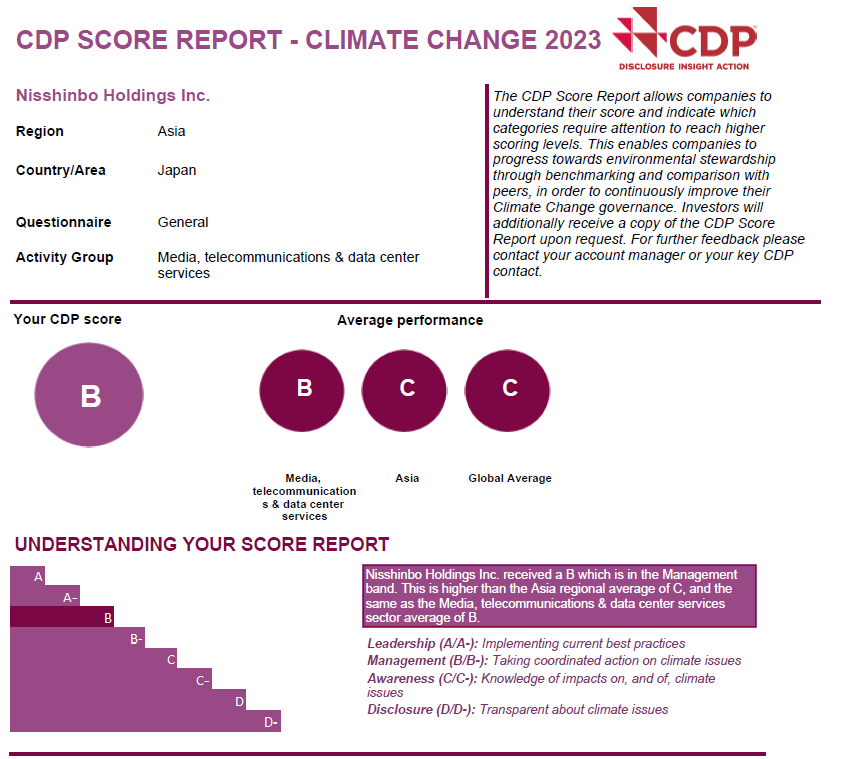
Selected as a "Zero Emissions Challenge Company" by METI
The following initiatives were highly evaluated, and each of the initiatives has been selected as Zero Emissions Challenge Companies by the Ministry of Economy, Trade and Industry of Japan: Technology Development Project for Social Implementation of Marine Biodegradable Plastics by Nisshinbo Holdings Inc.; Project for Realization of Energy-Saving Society with Robots and Drones by Japan Radio Co. Ltd.; and Industry-Academia-Government Collaboration Problem-solving Research and Development Project about Advancement of Fuel Cells, etc. Technologies and Utilization Project by Nisshinbo Chemical Inc.
In collaboration with Keidanren, the New Energy and Industrial Technology Development Organization (NEDO), and the Ministry of Agriculture, Forestry and Fisheries (MAFF), METI is working on the Zero Emissions Challenge project, which lists the companies that are accepting the challenge of innovation aimed at achieving 2050 carbon neutrality and which provides investors with useful information.
In cooperation with the Federation of Keidanren, NEDO and MAFF, METI has positioned the company as a Zero Emi Challenge Company to accept the challenge of innovation efforts in order to achieve a decarbonization society. METI announced the TCFD Summit 2021 in October 2021 as a second issue following 2020.
The list of companies covers programs run by METI and MAFF tied to the Zero Emission Innovation Strategy, and 45 projects run by NEDO. A total of approximately 600 companies that agreed to the aims of the Zero Emi Challenge are listed.
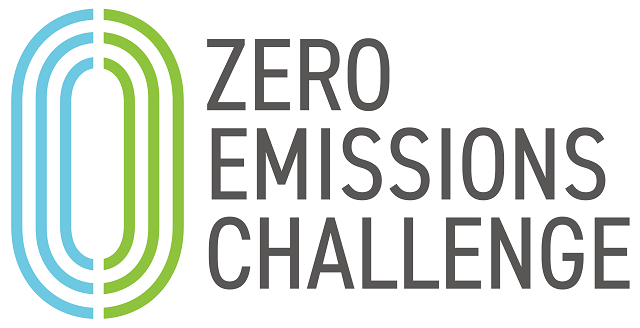
Participation in Keidanren's Challenge Zero
The Nisshinbo Group participates Challenge Zero (Challengenet Zero Carbon Innovation), a project led by the Federation of the Japanese Economic Organization (hereinafter referred to as the "Keidanren"), participates.
Challenge Zero is a new initiative in which the Keidanren, in cooperation with the Japanese government, strongly promotes and publicizes innovative action by companies and organizations in Japan and overseas that are tackling the challenge of realizing a "decarbonizing society". This initiative positions the aims of the International Framework for Climate Change Control, known as the Paris Agreement, as a long-term goal.
In light of the goal of Challenge Zero, Nisshinbo Holdings Inc. will promote the creation of innovation in order to reduce greenhouse gases and contribute to the realization of a carbon-free society through its business activities.
Keidanren's official "Challenge Zero" website
https://www.challenge-zero.jp/en/
![]()
View case studies of the Group's efforts to realize a decarbonizing society is presented.

Specific Activities of the Group Companies
Telemetering Station System Utilizing Solar Cells
The telemetering system of Japan Radio Co., Ltd. measures water levels, precipitation, and other data on the natural environment of dams and rivers and automatically collects this information via wireless lines. This information is used for river management, which is important for environmental conservation, such as disaster prevention and the efficient use of water resources.
Telemetering systems consist of observation stations that collect and transmit data, monitoring stations that receive and aggregate transmitted data, and satellite stations that relay data to locations that cannot be reached directly by radio. For observation and satellite stations, especially in mountainous areas where commercial power sources are not available, Japan Radio offers environmentally friendly products that generate power from solar cells. The estimated 10-year reduction in greenhouse gas emissions for the facility currently in operation, calculated based on actual shipments, is approximately 144 t-CO2 (10,296 cedar trees). This facility is a critical infrastructure facility, yet it is also environmentally friendly and allows for the collection of important data for river management.
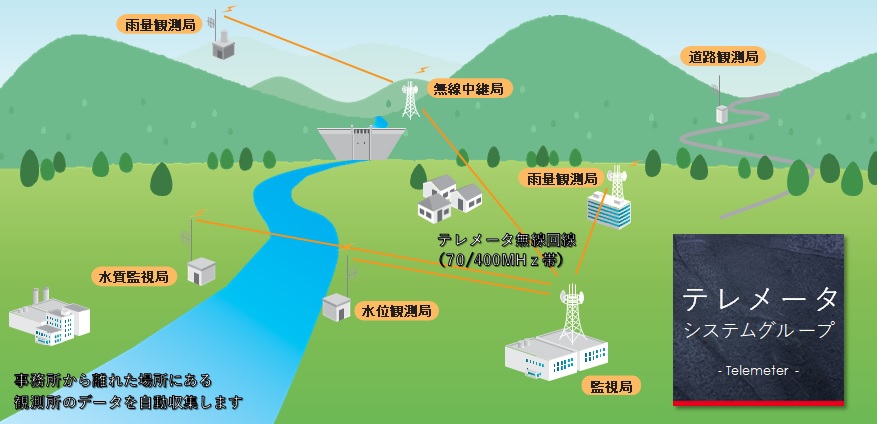
Stem Count, Ear Water Content, and Fertilizer Application Mapping Services for Wheat Fields
Japan Radio Co., Ltd. launched farmINSIGHT, a farm management support service using satellite data in March 2024.
This service uses proprietary AI technology to visualize growth indicators (e.g., number of stalks and ear moisture content) for fall-sown wheat. This enables farmers to accurately grasp the growth conditions and take the appropriate action in accordance with the farmer's guide. Using the stem number map and fertilizer application map, farmers can apply fertilizer according to fertilizer standards, which is expected to reduce the amount of fertilizer applied and increase the yield. In addition, by using the ear moisture content map and the optimal harvest time map, farmers will be able to plan for the optimal use of combine harvesters, which is expected to increase utilization and reduce fuel consumption. This approach is expected to have the following effects from a sustainability perspective:
- ① Stabilization of wheat yield: Contribution to stable food supply
- ② Reduction of chemical fertilizers: Reduction of environmental impact on farm fields
- ③ Improved combine operation rate: Reduction of CO2 emissions
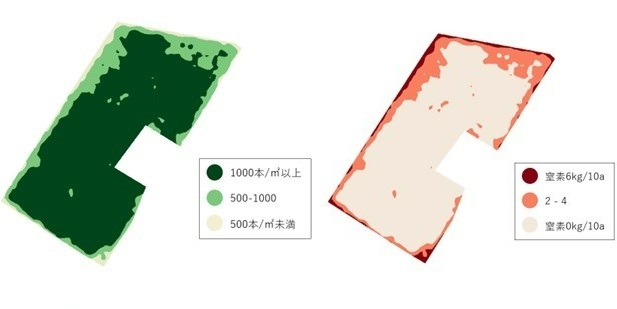
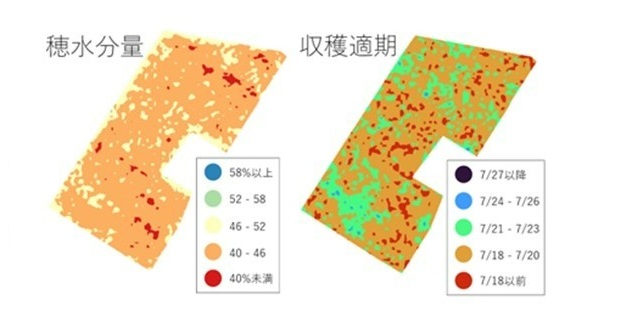
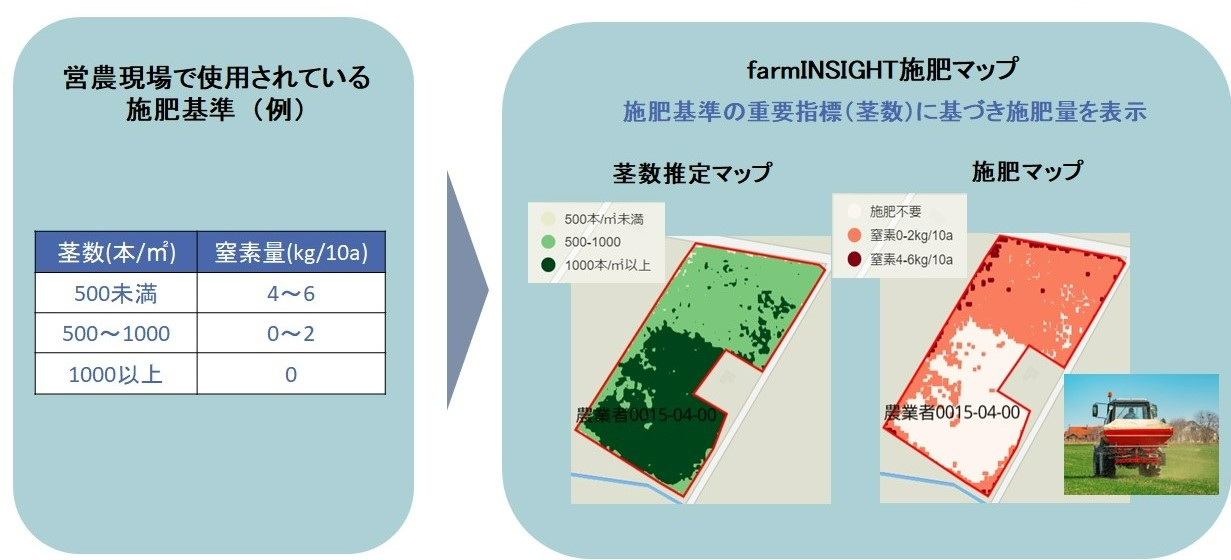
Introduction of Shinshu Green Denki
Japan Radio Co., Ltd., Nagano Plant, Nagano Japan Radio Co., Ltd., Head Office & Factory, and Ueda Japan Radio Co., Ltd., Head Office & Main Factory in the Wireless and Communications business have begun purchasing electricity from Chubu Electric Power Miraiz Company, Incorporated, as part of the electricity used at the Nagano Plants from April 2023. This electricity system includes the electricity produced at a hydroelectric power plant operated by the Nagano Prefecture Public Enterprise Bureau, and Shinshu Green Denki (CO2-free electricity), which is utilizing non-fossil certificates derived from the power plant.
Shinshu Green Denki is an earth-conscious, locally produced, locally consumed electricity that comes from the abundant water sources in Shinshu, including the Sai-gawa, Chikuma-gawa, and Kiso-gawa rivers that run through Nagano Prefecture. The Wireless and Communications Group purchased 1,908 MWh of non-fossil certificates (1,350 MWh from Japan Radio Co., Ltd., 360 MWh from Nagano Japan Radio Co., Ltd., and 198 MWh from Ueda Japan Radio Co., Ltd.) in the nine months from April to December 2023. This is equivalent to 875 t-CO2 emissions* in terms of greenhouse gases.
* Calculated using Chubu Electric Power Miraiz Company Incorporated's emission factor published by the Ministry of the Environment on December 22, 2023.
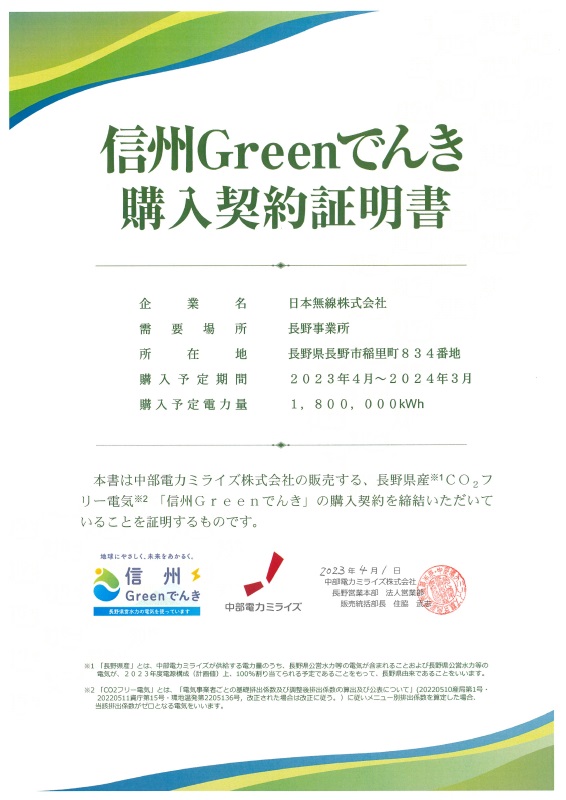
Introduction of Hybrid Power Generation Facility
Asashina Nichimu Co., Ltd. installed a hybrid renewable energy generation facility capable of generating both wind and solar power in September 2023.
Wind and solar power are used during the day, and wind power is used at night with a maximum generation of 200 Wh from wind and 220 Wh from solar power. Electricity stored in storage batteries is used to light the company name signboard at night using LEDs. The facility also possesses a 100 V outlet, which can be used for nighttime lighting or in emergencies such as power outages. In addition, the facility can charge approximately 250 smartphones and is being considered for opening to local residents in the event of a disaster. The company believes that by installing this facility, they can appeal to the public as an environmentally conscious company and also contribute to the local community.
This time, the company has reduced CO2 emissions by creating renewable energy through power generation facilities that take advantage of the windy climate characteristics of the Asashina region, and they will continue to promote measures to combat climate change on an ongoing basis, including the installation of new lightweight solar panels.
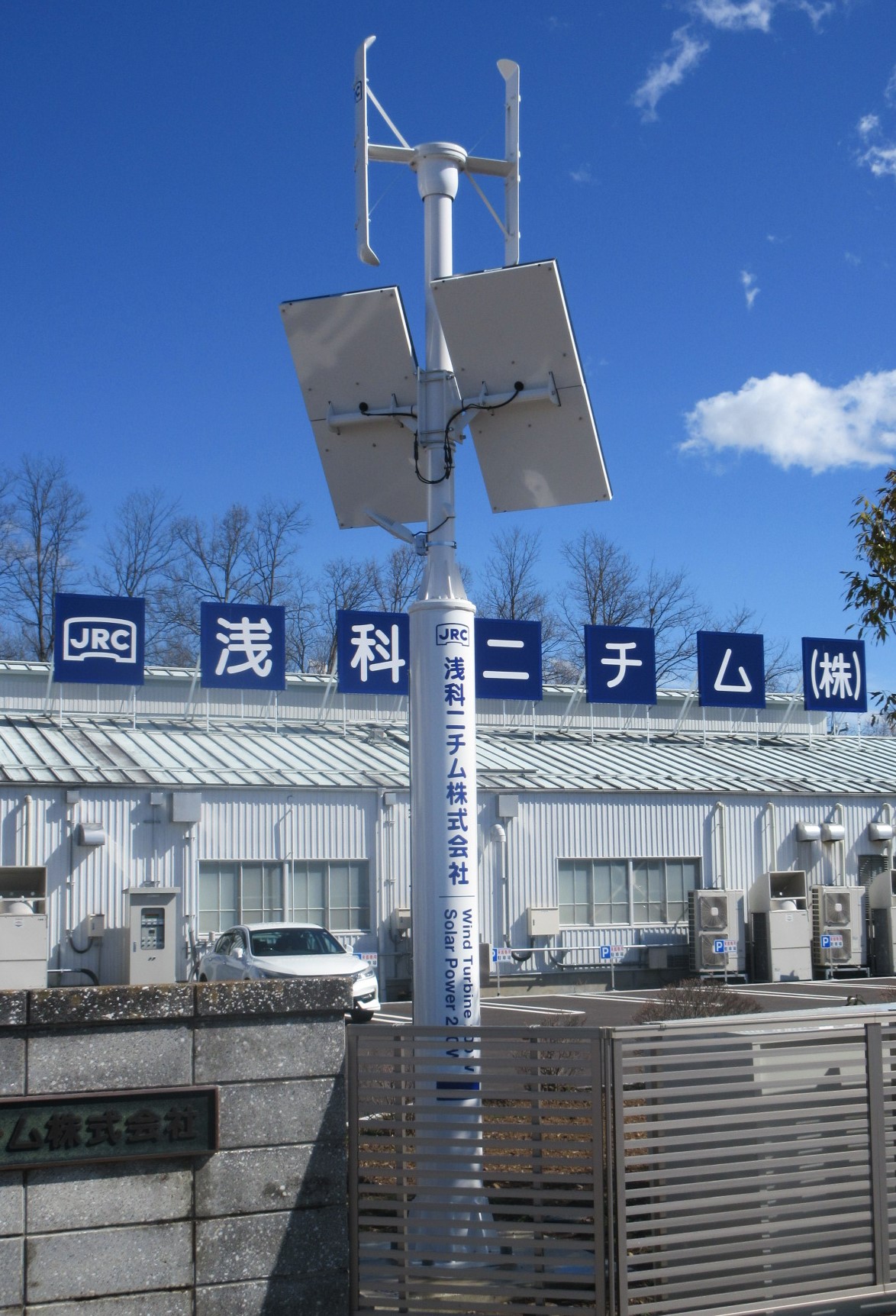
Reduction of Greenhouse Gas Emissions by Installing Abatement Equipment
Nisshinbo Micro Device Inc. Yashiro Plant has installed PFCs abatement system*. This important system thermally decomposes PFCs (SF6, C2F6, C4F8, NF3, etc.) generated in the semiconductor wafer manufacturing process, which cause global warming, to reduce emissions of greenhouse gases that contribute to global warming.
The introduction of this system will reduce the company's annual emissions of non-energy origin greenhouse gases by 7,229 t-CO2 per year (15% of the FY2022 level).
* The PFCs abatement system uses a plasma system that decomposes and treats PFCs using ultra-high-temperature (nearly 2,000°C) plasma heat. Nitrogen gas is introduced in the plasma torch to generate high-temperature plasma, which decomposes persistent PFCs (process gas).
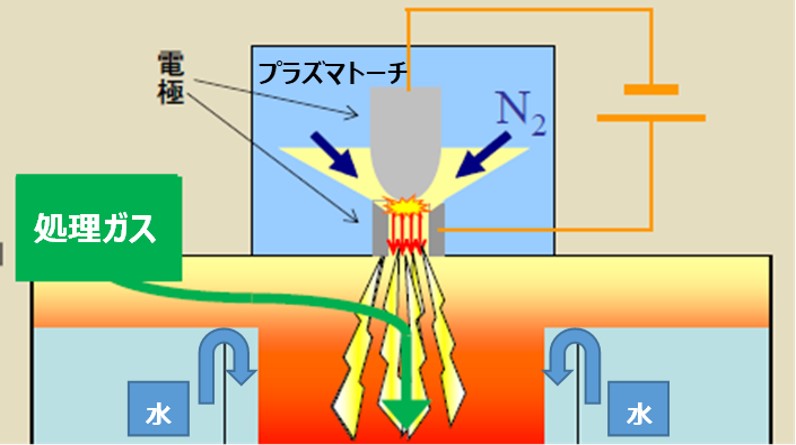
Measures to Reduce Greenhouse Gas Emissions
Nisshinbo Micro Devices Fukuoka Co., Ltd. has set a target to reduce greenhouse gas emissions by 30% or more from the FY2014 emissions level of 45,564 t-CO2/year by the end of FY2023. In FY2023, the following measures were mainly implemented:
- ① Installed and began operation of second PFCs abatement system
The company has begun taking countermeasures against the gas (C3F8: 8,830), which is used frequently and has a high global warming potential (GWP), by installing a detoxification system. - ② Extract production facilities that will not contribute to production because of a decrease in production volume from June 2023 onward and will implement power-saving shutdowns to curb unnecessary power consumption.
- ③ Introduction of next-generation environmentally friendly non-CFC inverter turbo chillers* begin operation.
*Facilities using non-CFC refrigerants (1233zd(E), GWP factor 1)
In FY2023, total emissions were 24,771 t-CO2/year, a 46% reduction (20,793 t-CO2/year), and the target was achieved, despite a decrease in the use of C3F8 gas and other gases due to lower production volumes since June. Compared to FY2022, this has resulted in a 25% reduction or 8,301 t-CO2/year.
The company will continue its activities to achieve the Nisshinbo Group's Three-Year Environmental Targets (reduction of 35% or more from the FY2014 level by FY2024).
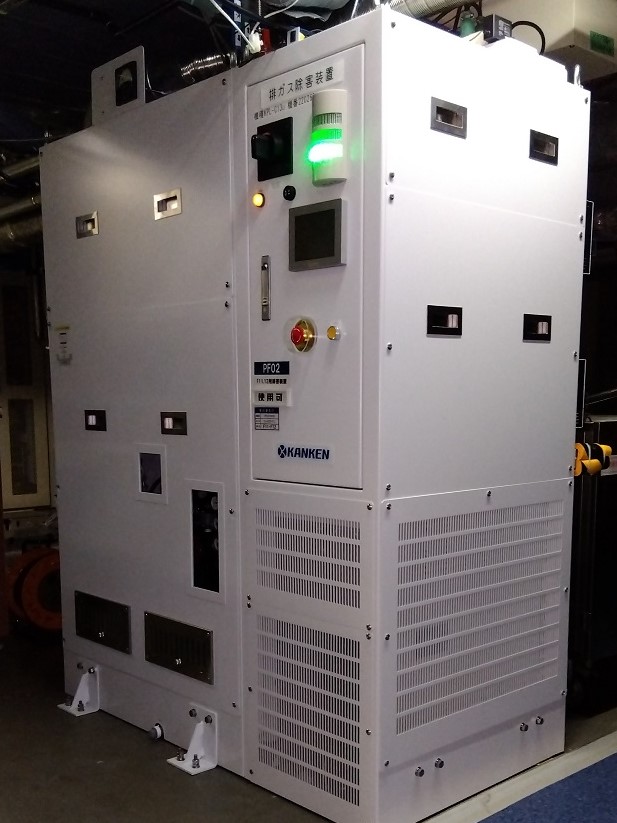
Expansion of Solar Power Generation Equipment
In December 2022, Nisshinbo Brake Inc. Tatebayashi Plant added a 500 kW solar power generation equipment to the roofs of its plant and distribution center buildings. Therefore, together with the 300 kW solar power generation equipment installed in September 2011, a total of 800 kW of electricity can now be generated by the solar power generation equipment. The solar power generation equipment generated approximately 1,280 MWh of electricity in FY2023. This amount of power generation accounted for approximately 4% of the electricity used at the Tatebayashi Plant, resulting in a reduction of approximately 518 t-CO2 in terms of CO2 emissions.
The company is considering adding more solar power generation equipment and hopes to replace about 10% of the electricity used at the Tatebayashi Plant in the future with renewable energy.
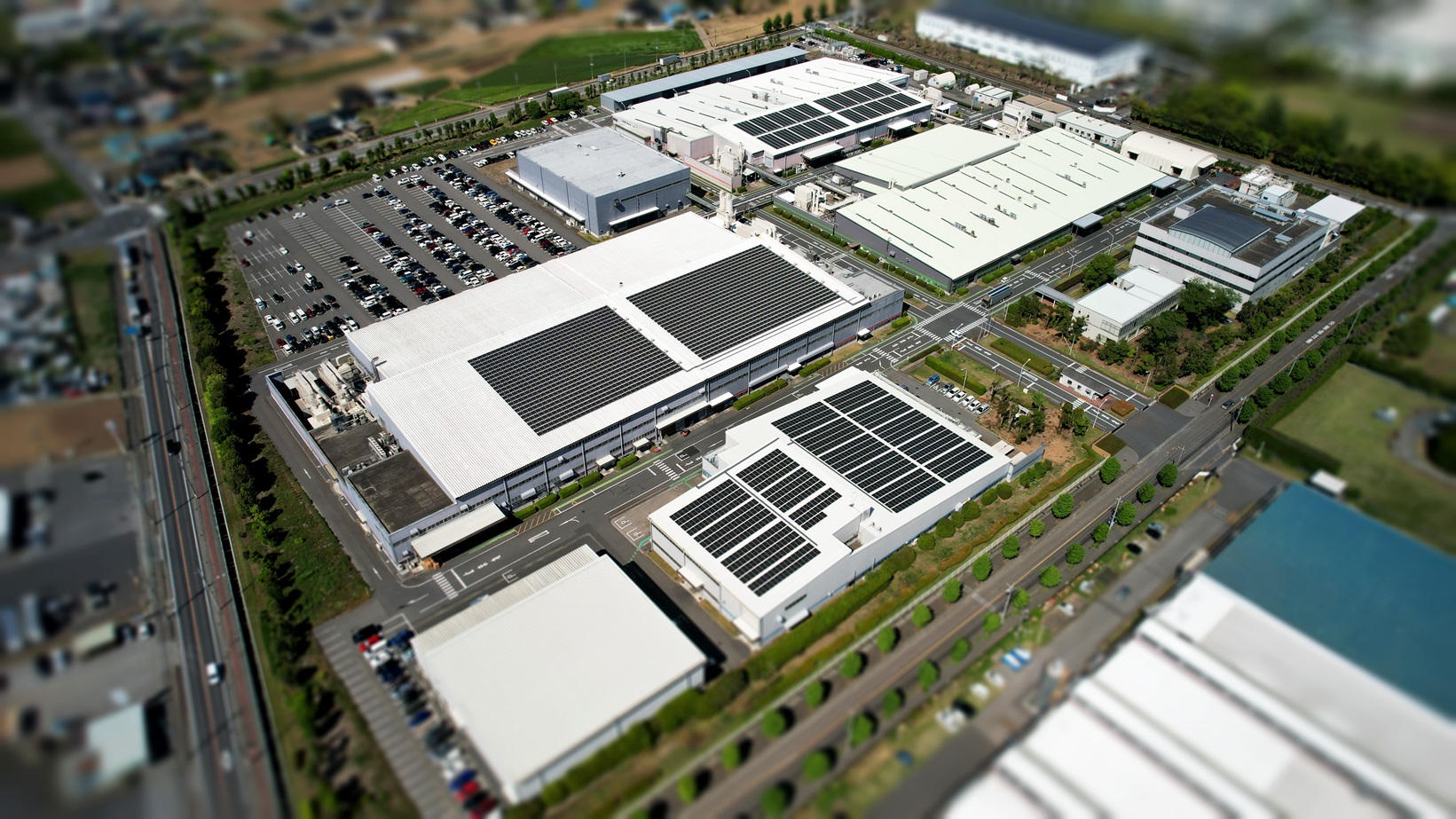
Renewal of Heat Transfer Boiler
At the Nisshinbo Chemical Inc. Tokushima Plant, a chemical reaction is accelerated in the manufacturing process of the resin additive CARBODILITETM by heating a reaction vessel with a heat medium. Oil is used as the heating medium and is heated and circulated by the boiler to heat the reaction vessel. Previously, only one kerosene-fired boiler was in operation, but two high-efficiency city gas-fired boilers were installed to continue operations and reduce the environmental impact.
This has reduced the risk of shutdowns in the event of equipment failure. Furthermore, the introduction of boilers with reduced combustion capacity per unit has resulted in the exclusion of smoke-generating facilities. In addition, city gas contains almost no sulfur oxides, reducing the environmental impact. High-efficiency city gas-fired boilers offer high boiler efficiency thanks to a system that uses exhaust gas to preheat the introduced air during combustion, and the change of fuel from kerosene to city gas has also contributed to CO2 reduction. The reduction was approximately 42% (63 t-CO2) from the FY2022 level based on the actual results for 2023.
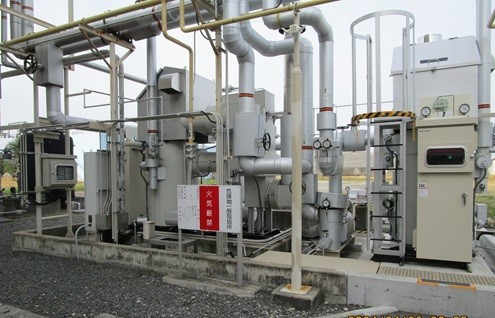
Non-CFC Urethane Products
Nisshinbo Chemical Inc.'s non-CFC urethane products are environmentally friendly rigid urethane that uses carbon dioxide gas generated by a special reaction of isocyanates as a foaming agent and do not use CFCs at all. The company sells its products in various forms and specifications, including processed products and undiluted solutions in response to customer requests.
Processed products are used as tank components for LNG, which is considered a clean energy source, and undiluted solution is used for insulation panels, commercial refrigerators, and heat insulators for homes, contributing to global environmental conservation as an eco-friendly, energy-saving material.
Examples of applications are as follows:
- ① Cold chain related (refrigerated vessels, refrigerated/chiller trucks, refrigerated/chill storage, etc.)
- ② Plant and transportation (LNG/LPG tanks, liquefied gas tankers, beer tanks, etc.)
- ③ Housing and construction (RC and wooden houses, exterior siding, bathtubs, etc.)
- ④ Civil engineering (backfilling of tunnels, repair of leaks in concrete structures, etc.)
- ⑤ Others (sporting goods, automobile-related, modeling, beauty and hairdressing wigs, etc.)
Upgrading to Non-CFC Refrigeration Equipment
Nisshinbo Do Brasil Industria Textil LTDA. in Brazil uses refrigeration equipment with R22 CFC gas as the refrigerant for cooling the groundwater used for air conditioning in the plant and is in the process of upgrading to non-CFC refrigeration equipment from 2023.
Of the six old refrigeration units that use CFC gas, one was replaced in 2023, bringing the current total to five. The company plans to replace one unit/year, all of which will be non-CFC refrigeration equipment in the future. The company has decided to renew one unit for 2024 as well and is currently working on the foundation.
The global warming potential of the non-CFC HFO-1233zd used in the updated chillers is less than 1, compared to the 1,810 global warming potential of the CFC gas R22 used in the old chillers as a refrigerant.
The company, which will celebrate its 50th anniversary in 2024, is proactively addressing climate change issues by investing in the renewal of older facilities that have a high environmental impact.
